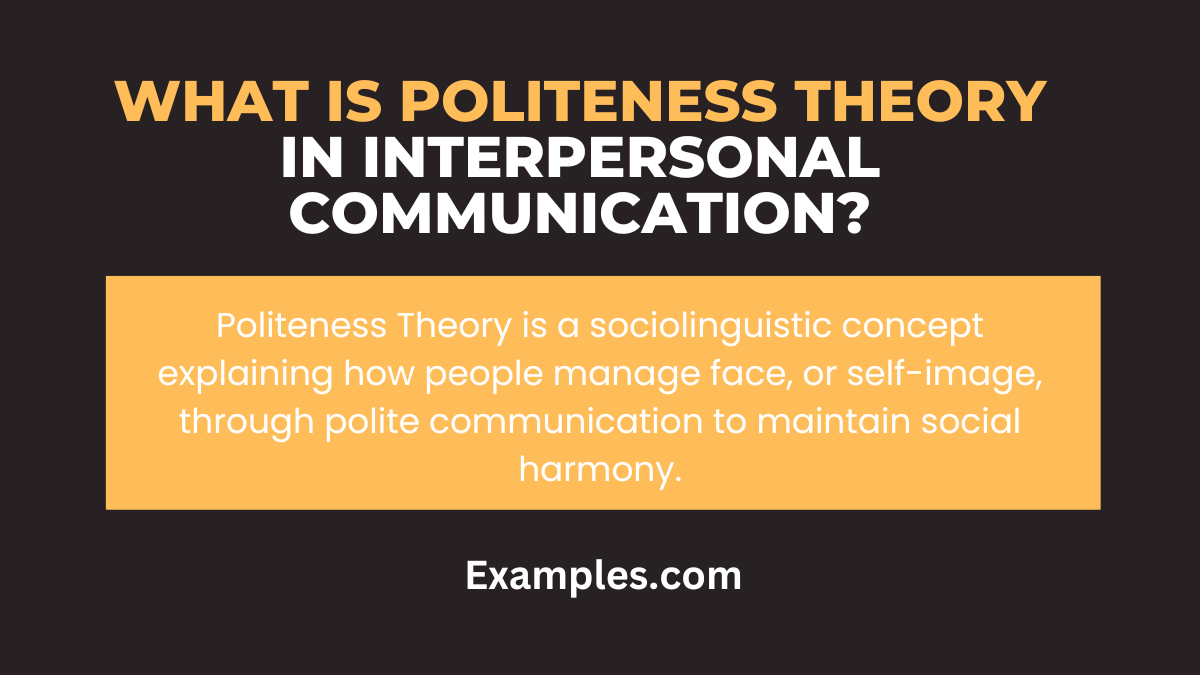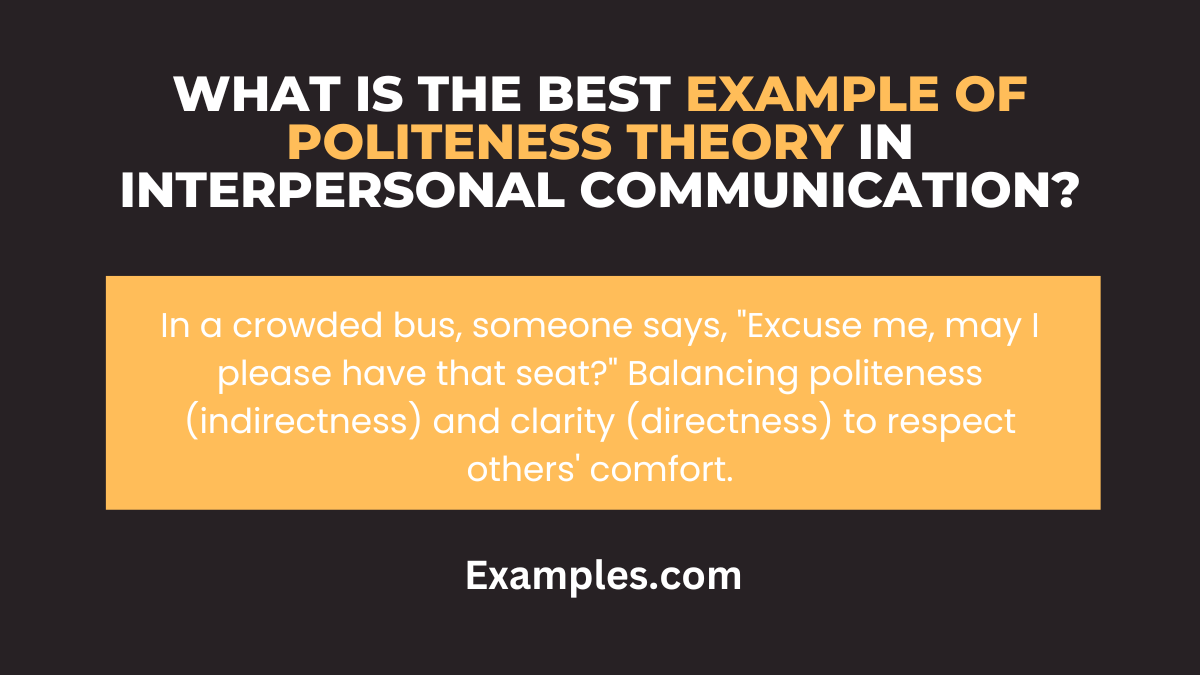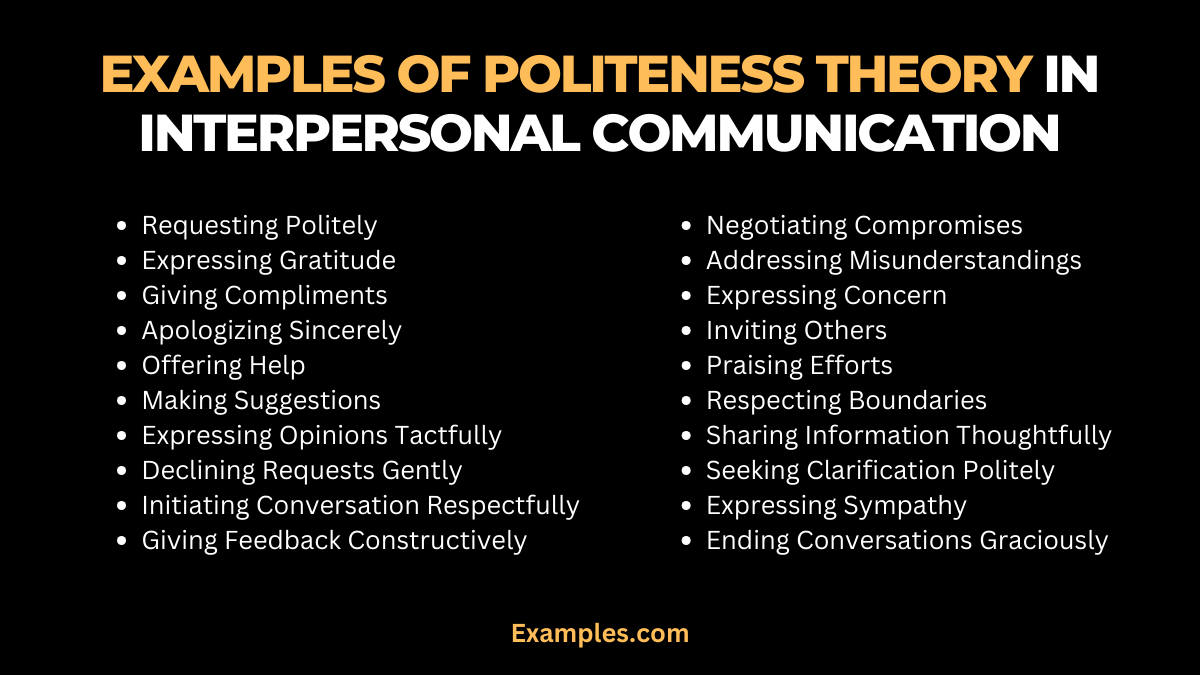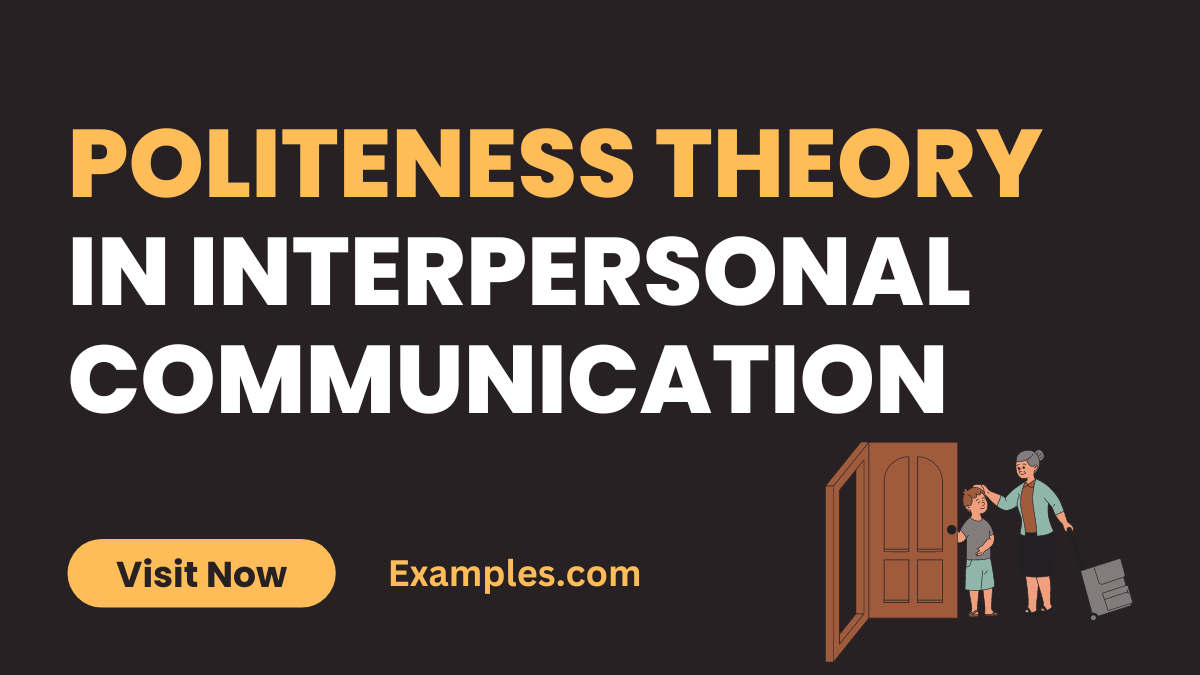19+ Politeness Theory in Interpersonal Communication Examples
In today’s interconnected world, Interpersonal Communication plays a pivotal role in forging meaningful relationships. Politeness Theory, a cornerstone in understanding these interactions, offers invaluable insights into the nuances of human dialogue. This guide delves into the heart of Politeness Theory, illustrating its principles with real-life examples. By embracing this theory, one can navigate the complexities of communication with grace and effectiveness, enriching both personal and professional relationships.
What is Politeness Theory in Interpersonal Communication?

Politeness Theory is a critical concept in Interpersonal Communication. It revolves around the idea of managing relationships through tactful speaking and respectful listening. This theory suggests that individuals inherently desire to maintain positive self-image and interpersonal relationships. Understanding Politeness Theory helps in decoding the subtle cues in conversation, leading to more harmonious and effective communication.
History
Who created: Penelope Brown and Stephen Levinson
Date: 1978
This theory suggests that individuals have a natural desire to save face, and thus, they employ various strategies to mitigate threats to their self-esteem or their interpersonal relationships. It plays a crucial role in verbal communication in interpersonal communication, influencing how individuals choose words and phrases to avoid offending others, especially in sensitive social situations.
What is the Best Example of Politeness Theory in Interpersonal Communication?

A prime example of Politeness Theory in action involves a manager providing feedback to an employee. Instead of blunt criticism, the manager uses constructive language, maintaining the employee’s self-esteem while effectively communicating the message. This approach not only preserves the professional relationship but also encourages a positive and open communication environment. Such instances exemplify the profound impact of Politeness Theory in everyday Interpersonal Communication scenarios, highlighting its relevance and necessity.
20 Examples of Politeness Theory in Interpersonal Communication

Politeness Theory plays a pivotal role in Interpersonal Communication. It guides how individuals interact in various social contexts, enhancing mutual respect and understanding. This theory is crucial in verbal and non-verbal exchanges, impacting relationships and social dynamics. Grasping Politeness Theory is essential for effective communication, ensuring courteous and considerate interactions. Here are 20 examples that illustrate its application in everyday communication.
- Requesting Politely: “Could you please help me with this report?” This shows respect and consideration for the other person’s willingness to help.
- Expressing Gratitude: “Thank you so much for your assistance.” Acknowledges the effort and support of others.
- Giving Compliments: “You did a great job on that presentation!” Positive reinforcement that fosters good relationships.
- Apologizing Sincerely: “I’m sorry for any inconvenience caused.” Shows accountability and the desire to maintain harmony.
- Offering Help: “May I assist you with that?” Demonstrates willingness to support and collaborate.
- Making Suggestions: “Have you considered trying this method?” Proposes ideas without imposing.
- Expressing Opinions Tactfully: “I see it differently, but I understand your point.” Balances expressing personal views with respect for others’ perspectives.
- Declining Requests Gently: “I appreciate the offer, but I can’t commit at this time.” Politely refuses without causing offense.
- Initiating Conversation Respectfully: “Excuse me, may I have a moment of your time?” Recognizes and respects the other’s space and time.
- Giving Feedback Constructively: “Your work is great, and with a bit more detail, it could be even better.” Encourages improvement without demoralizing.
- Negotiating Compromises: “Let’s find a middle ground that works for both of us.” Seeks mutually beneficial solutions.
- Addressing Misunderstandings: “I think there might be a misunderstanding here, let’s clarify.” Aims to resolve conflicts amicably.
- Expressing Concern: “I’m here if you need to talk.” Shows empathy and availability for support.
- Inviting Others: “Would you like to join us for lunch?” Inclusive approach that fosters social bonds.
- Praising Efforts: “Your hard work really shows in the results.” Recognizes and values others’ efforts.
- Respecting Boundaries: “I understand if you’re not comfortable discussing this topic.” Honors personal limits and privacy.
- Sharing Information Thoughtfully: “I thought this might be interesting to you.” Shares relevant information without overwhelming.
- Seeking Clarification Politely: “Could you please explain that point again?” Asks for more information respectfully.
- Expressing Sympathy: “I’m sorry to hear about your loss.” Shows compassion and understanding.
- Ending Conversations Graciously: “It was great talking to you, let’s catch up again soon.” Leaves a positive and open-ended conclusion to interactions.
Importance of Politeness Theory in Interpersonal Communication
Politeness theory plays a pivotal role in Interpersonal Communication. This theory, rooted in the work of Penelope Brown and Stephen Levinson, emphasizes how individuals navigate and negotiate social distances and relational power dynamics through language and behavior. In interpersonal communication, politeness is not just about manners or etiquette; it’s a fundamental mechanism by which people create and maintain social relationships and avoid conflicts.
- Facilitating Positive Relationships: Politeness theory aids in fostering amicable relationships. By using polite language and behavior, individuals show respect and consideration for others’ feelings and perspectives, which is essential in building trust and rapport.
- Managing Face Needs: The concept of ‘face’—an individual’s self-esteem or public image—is central to politeness theory. In interpersonal interactions, people often strive to protect their own face and the face of others. This mutual face protection helps in avoiding embarrassment or offense, thus maintaining harmonious relations.
- Reducing Conflict: Politeness can act as a buffer in potentially contentious situations. By softening requests or criticisms, individuals can reduce the likelihood of conflict, ensuring smoother and more effective communication.
- Navigating Power Dynamics: Politeness is key in managing power imbalances. It allows individuals in lower power positions to communicate with those in higher power positions in a manner that is respectful yet assertive.
- Enhancing Communication Effectiveness: Polite communication often leads to clearer and more effective exchange of ideas. When people feel respected, they are more likely to listen actively and engage constructively.
Strategies of Politeness Theory in Interpersonal Communication
Implementing politeness theory in interpersonal communication involves various strategies that cater to different communication needs and contexts. These strategies help in maintaining a balance between expressing oneself honestly and respecting the social and emotional needs of others.
- Positive Politeness: This strategy focuses on expressing friendliness and showing interest in the other person. It includes compliments, expressions of solidarity, and emphasizing common ground. Positive politeness strengthens social bonds and is particularly effective in Interpersonal Communication involving peers or friends.
- Negative Politeness: Used to show respect for the other person’s need for autonomy and space. It includes being indirect, using hedges or minimizers, and apologizing for intrusions. This strategy is vital in formal or hierarchical settings, such as in workplace communication or in Interpersonal Communication with Patients.
- Bald On-Record: Direct and unambiguous communication, used when there is a need for efficiency or in emergencies. While it may appear impolite, it is essential in situations where clarity is paramount, like in Interpersonal Communication for Project Managers.
- Off-Record: This indirect strategy involves hints or suggestions. It allows the speaker to avoid direct responsibility for the request or statement, reducing potential face threats. This is useful in sensitive situations where directness might be perceived as offensive.
Principles of Politeness Theory in Interpersonal Communication
Understanding the principles of politeness theory is crucial for effective interpersonal communication. These principles guide individuals on how to interact in ways that respect social norms and individual preferences.
- Understanding of Face Needs: Recognizing the importance of ‘face’ and how it influences people’s reactions and interactions. This involves being aware of how actions or words might affect someone’s self-esteem or social standing.
- Adaptability: The ability to adjust communication style based on the context, relationship, and cultural norms. This includes choosing the appropriate politeness strategy to match the situation, whether it’s in a personal relationship or professional setting like Interpersonal Communication in Business.
- Contextual Awareness: Being aware of the social context and the roles and relationships of the people involved. This helps in determining the level of formality or informality required in the communication.
- Empathy and Sensitivity: Understanding and acknowledging others’ feelings and perspectives. This involves actively listening and responding in a way that shows consideration for their emotions and viewpoints.
- Balance Between Honesty and Respect: Finding the right balance between being honest and not offending others. This includes being tactful and knowing when to be direct and when to be more circumspect.
Politeness Theory underscores the role of courteous language in effective interpersonal communication. To apply this theory, focus on tactful language use, considering others’ feelings and social contexts. By practicing polite speech, you foster positive interactions and avoid misunderstandings. Mastery of politeness in communication not only enhances relationships but also builds a respectful and empathetic communication environment.



